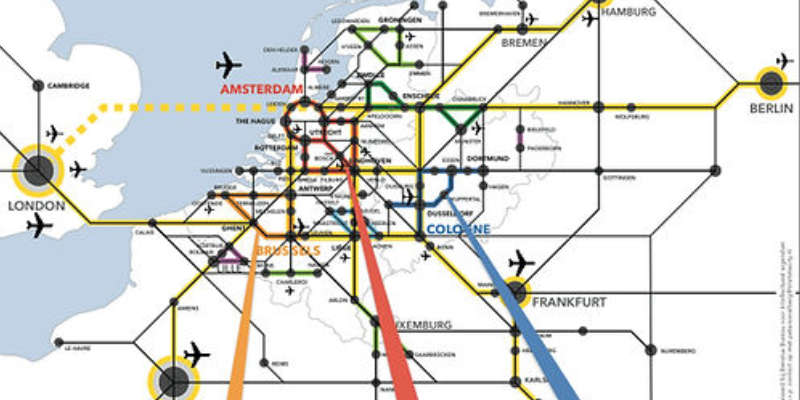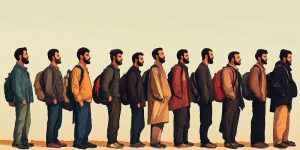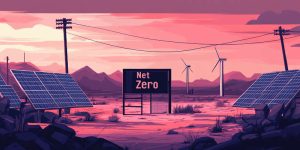Tristate City: The Overhaul of the Netherlands at the Expense of Its Citizens

The concept of Tristate City is often presented as an ambitious and futuristic urban development plan that will transform the Netherlands into a densely populated megaregion, integrating parts of Belgium and Germany. It is heavily promoted by globalist think tanks, the European Union, and multinational corporations, who argue that it will make the region a global economic powerhouse. However, behind the polished narrative lies a project that prioritizes economic expansion and mass urbanization over the well-being of Dutch citizens.
The plan envisions the Netherlands as a hyper-dense urban hub with a drastically increased population, making it one of the most crowded areas in the world. With significant backing from corporate lobbies, EU policymakers, and real estate investors, the Tristate City initiative is not just about urban planning—it is a major step toward further eroding Dutch national sovereignty in favor of a centralized European superstate (Tristate City, “Concept Plan”, 2023).
The Disregard for Dutch Citizens
Overpopulation and Loss of Open Space
The Netherlands is already one of the most densely populated countries in Europe. The Tristate City plan will dramatically increase urban density, further reducing green spaces, farmland, and the overall quality of life. The Netherlands’ unique rural landscape, known for its fields, forests, and waterways, is at risk of being replaced by a sprawling concrete metropolis (CBS, “Demographic Density and Urban Growth”, 2023).
Dutch citizens will face increased housing shortages, as real estate prices skyrocket due to the focus on high-density urban development. Instead of prioritizing sustainable housing for Dutch families, the plan caters to an influx of new international workers, many of whom will not share a connection to the country’s cultural and social values (Planbureau voor de Leefomgeving, “De Gevolgen van Stedelijke Verdichting”, 2023).
Destruction of Agriculture and Food Security
One of the most controversial aspects of the Tristate City vision is the reduction of farmland to make way for more housing and infrastructure projects. The Netherlands is a global leader in agriculture and food production, yet under this plan, thousands of Dutch farmers will be displaced, and traditional agricultural lands will be repurposed for urban expansion (Rijksinstituut voor Volksgezondheid en Milieu, “Ruimtelijke Ordening en Voedselzekerheid”, 2023).
This compromises national food security, increasing dependence on foreign food imports while eliminating one of the Netherlands’ most successful industries. It is no coincidence that this urbanization plan aligns with EU climate policies that are already putting immense pressure on Dutch farmers under the guise of nitrogen regulations.
Strain on Infrastructure and Public Services
With a massive population increase, public infrastructure will be pushed to its limits. Roads, railways, hospitals, and schools will struggle to accommodate the influx of people.
- Healthcare: Dutch hospitals already face long wait times and staffing shortages. Increasing the population will further strain the system, reducing accessibility and quality of care (Nederlandse Zorgautoriteit, “Capaciteitsproblemen in de Gezondheidszorg”, 2023).
- Traffic Congestion: The Dutch transport system is well-developed but not designed for an exponential population increase. The expansion will lead to severe congestion, increased travel times, and higher maintenance costs for roads and railways (Ministerie van Infrastructuur en Waterstaat, “Mobiliteit en Bevolkingsgroei”, 2023).
- Education: Schools and universities will face overcrowding, with Dutch students losing educational opportunities due to the prioritization of international enrollment and foreign labor demands (Onderwijsraad, “De Impact van Stedelijke Groei op Onderwijs”, 2023).
Loss of National Identity and Social Cohesion
The Tristate City project does not account for the importance of Dutch culture, traditions, and national identity. Instead, it promotes an internationalist approach where economic interests override historical and social values.
With the massive influx of foreign workers and the prioritization of multinational corporate interests, there will be increasing social fragmentation. Dutch citizens will be expected to accommodate rapid demographic changes while receiving little benefit in return (SCP, “Identiteit en Samenleving in de 21e Eeuw”, 2023).
Who Benefits from Tristate City?
While Dutch citizens will bear the negative consequences, the true beneficiaries of the Tristate City project are multinational corporations, global financial elites, and EU policymakers who seek to turn the Netherlands into a centralized economic hub:
- Corporate interests: Large multinational companies will have access to an expanded workforce at the expense of Dutch workers.
- Real estate investors: Housing prices will skyrocket, benefiting property developers and landlords while making homeownership unattainable for ordinary Dutch families.
- The EU and globalist policymakers: The Netherlands will be further integrated into a European superstate, losing more of its national sovereignty in the process.
Conclusion: A Project That Serves the Globalists, Not the Dutch People
The Tristate City vision may be framed as an innovative and progressive development plan, but in reality, it is a globalist blueprint that prioritizes economic expansion and mass migration over the well-being of Dutch citizens. It undermines national sovereignty, destroys agricultural land, worsens infrastructure stress, and erodes Dutch cultural identity.
For the Netherlands to remain a country where its own citizens’ needs come first, it is crucial to reject plans like Tristate City and prioritize policies that protect Dutch farmland, preserve national identity, and maintain a livable, sustainable country for future generations.
References
- Tristate City, “Concept Plan”, 2023
- CBS, “Demographic Density and Urban Growth”, 2023
- Planbureau voor de Leefomgeving, “De Gevolgen van Stedelijke Verdichting”, 2023
- Rijksinstituut voor Volksgezondheid en Milieu, “Ruimtelijke Ordening en Voedselzekerheid”, 2023
- Nederlandse Zorgautoriteit, “Capaciteitsproblemen in de Gezondheidszorg”, 2023
- Ministerie van Infrastructuur en Waterstaat, “Mobiliteit en Bevolkingsgroei”, 2023
- Onderwijsraad, “De Impact van Stedelijke Groei op Onderwijs”, 2023
- SCP, “Identiteit en Samenleving in de 21e Eeuw”, 2023


















